| Lot |
Photo |
Description |
Realized |
Lot 990 |
 |
A Rare Moon Rock From a Lunar Meteorite. A Lunar meteorite designated Dhofar 1180 was found by meteorite hunter Mike Farmer in the deserts of Oman on Jan. 18, 2005. This lunar meteorite weighed 115 grams and was officially analyzed and determined to be from the moon and given the official designation Dhofar 1180. This sizeable but affordable specimen is 32 x 22 mm in size and weighs 0.9164 grams. It has been polished and is dark gray in color with interesting white circular clasts. In meteorite terminology, it is a basalt (dark gray) bearing feldspathic regolith breccia that contains about 75% anorthositic material and 25% mare material. It is a breccia which means that the rock material was mixed from a molten state after a large meteorite struck the moon causing the moon rock to be vaporized and ejected from the lunar surface and it eventually found its way to earth. This rare lunar meteorite is housed in a special suspension box so that every part of its surface can be examined without removing the delicate thin section. It is also housed in a 5.5 x 4.5 inch Riker box for display.
Add $20 for domestic shipping.
Estimated Value $1,300 - 1,600.
View details and enlarged photo
| Unsold |
Lot 991 |
 |
Carbonado- a Black Diamond From Space. The rarest and hardest diamonds on earth come from outer space. Carbonados, dark and uncrystalized diamonds do not look like any other diamonds on earth because they were created by an exploding star before the formation of our solar system and delivered to Earth by an asteroid over two billion years ago. These rare diamonds are only found on the east coast of Brazil and the west coast of the Central African Republic which were joined together at the time of the meteorite impact over two billion years ago. Because of the lack of crystal structure, there are no shear planes in which to facet these fascinating black diamonds. (the color can vary from black to dark grey and dark green depending on their trace elements). The proof of an extraterrestrial origin is the presence of nitrogen and hydrogen in their matrix. The presence of hydrogen in Carbonados indicates that an origin in a hydrogen-rich interstellar space and formed from a supernova explosion of a star several times larger than our sun. Carbonados are never found in any diamond mines anywhere else in the world which is consistent with their origin from a single asteroid impact over two billion years ago with all other traces of the meteorite long weathered away with only the few small black diamonds remaining.
Most Carbonado black diamonds recovered have been small, weighing 3 carats or less. This large 22mm x 17mm, 23.83 carat shiny black stone is certainly the exception. It is completely original with a microscopic pebbly appearance of the individual diamond crystals being compressed together within the star during formation and is both beautiful and rare being older than any other rocks found on earth (older than 4.55 billion years).
Allow $20 for domestic shipping.
Estimated Value $1,600 - 2,200.
View details and enlarged photo
| Realized
$1,121 |
Lot 992 |
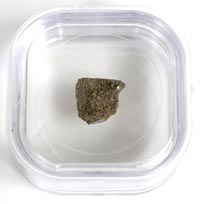 |
Famous Martian Meteorite. Zagami is a very famous single 40 pound Martian meteorite that fell Oct. 3, 1962 and nearly struck a farmer tending his fields in Nigeria. Meteorites are named after towns or geological formations such as a large rock named Zagami that was about .75 mile from this fall. The fresh black meteorite was found at the bottom of a two foot crater. Even though the interior of Zagami is a light cream color, the fusion crust was a black color from the intense heat of passing through earth�s atmosphere. Zagami has been identified as originating from Mars through analysis of its isotopic signatures of nitrogen, argon and zenon gases from mm sized pockets contained within shock melted glass. These isotopes match perfectly with the Viking spacecraft�s analysis of the Martian atmosphere. It is classified as a shergottite which means that is composed of igneous rocks from the Martian surface and crystallized on Mars about 150-200 million years ago and was blasted off the surface of Mars when a really large meteorite slammed into Mars several million years ago. This specimen is 12 x 11 mm weighing .8gram and is light colored with flecks of reflected shocked melted glass. It is preserved in a special membrane box that enables it to be viewed from all sides.
Add $15 for domestic shipping.
Estimated Value $800 - 1,200.
View details and enlarged photo
| Unsold |
Lot 993 |
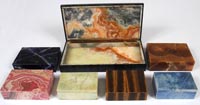 |
Group of Seven Boxes From A Variety of Natural Stones. An attractive lot, varying from 2½ x 3¾ x 1½" to 4¾ x 9¾ x 1½". Decorative by themselves or could be used to hold jewelry or other small items. Individual stone boxes have recently brought $2,000-$3,000.
Estimated Value $2,000 - 3,000.
Ex Superior Galleries Collectibles Auction, July 17, 1999.
View details and enlarged photo
| Unsold |
Lot 994 |
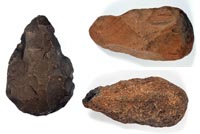 |
Hand Axe Collection From the Homo Heidelbergensis Culture. This collection of three hand axes are from the Achelean and are between 120,000 to 300,000 years old and were sculpted out of stone by an archaic Homo species such as Homo heidelbergensis that may have been one of the direct ancestors of Homo sapiens. These large heavy hand axes probably had multiple uses from cutting meat to use as a weapon. The most primitive 6.25 inch hand axe was selected based on its size and shape and just chiseled to form a sharp point and flat side to hold in a hand. The second 5.5 inch hand axe has a small number of cuts and a point that is not sharp. The third 5.75 inch hand axe is a splendid example that has multiple cuts forming not only a sharp point but also sharp edges and fits perfectly in the palm of the hand. These hand axes may have been made over the period of thousands of years and were found in the Western Sahara Desert. These are rare and interesting early human artifacts that show that early humans had hands similar in size and shape to our own.
Add $20 for domestic shipping.
Estimated Value $400 - 600.
View details and enlarged photo
| Unsold |
Lot 995 |
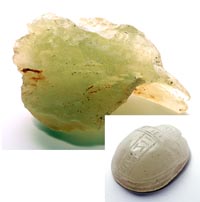 |
King Tutankhamun Style Scarab Made From Libyan Desert Glass Plus Large Libyan Desert Glass Nugget. When Howard Carter discovered King Tutankhamun's tomb in 1922, one of the precious metal amulets had a scarab carved out of a green colored glass that was clearly special as it was the center stone in the amulet. It turned out to be a piece of Libyan Desert Glass and was dated at 28 million years old. Libyan Desert Glass actually is a tektite of almost pure silica which formed 28 million years ago when a large meteorite exploded over the desert vaporizing itself and a lot of the sand at temperatures in excess of 3000 degrees. The molten sand quickly cooled and fell back to earth in a variety of shapes as pale yellow to yellow-green glass. These gemstones of the desert were highly valued by the ancient Egyptians and they continue to be so valued today. Libyan Desert Glass is only found in one section of the Great Sand Sea between Libya and Egypt and the likely meteorite crater named Kebira over 19 miles in diameter was found near the Libya-Egypt border. This lot contains a 1.25 inch long Egyptian style scarab with the eye of Rah carved on its back that is similar in style and size to the one in King Tut's amulet plus a very large 3 x 2 inch 132 gram premium pale green nugget of Libyan Desert Glass with a meteorite-like surface of craters and scoops. A smaller 125 gram piece of Libyan Desert Glass sold for $6,000 in a 2007 New York auction. Both specimens are housed in a 8 x 6 inch Riker mount.
Add $20 for domestic shipping.
Estimated Value $400 - 600.
View details and enlarged photos
| Unsold |
Lot 996 |
 |
Libyan Desert Glass. Tektites are a mixture of earth rocks mixed with a sprinkling of meteorite material from an immense explosive event that occurred when a very large rocky meteorite vaporized before impacting the earth. The resulting mixture forms glass-like mixture. The color is usually black but it can also be green or yellow depending on the amount of silica present. This huge 5 x 3.5 x 3 inch 896 gram (nearly two pounds) specimen of Libyan Desert Glass is unusually pristine from being buried in the Sahara sand (near the border of Libya and Egypt) with no sandblasting on the surface and a surface covered with small craters formed when gasses escaped when the glass solidified. It is a rather uniform medium greenish yellow color and somewhat reflective on all sides except for the flat bottom. Throughout the specimen there are small white spheres of Cristobalite which is a from of quartz that only forms at very high temperatures above 1470 degrees centigrade. The presence of Cristobalite proves the meteorite impact origin of Libyan Desert Glass as the only other way it could form in the desert would be from a volcano and there was never a volcano anywhere near this area. An extra bonus is the natural flat bottom making for a natural display. Such a large pristine piece of Libyan Desert Glass is rarely encounterd and is especially valuable as a small 125 gram specimen sold for over $6000 in a New York auction in October, 2007.
Add $20 for domestic shipping.
Estimated Value $800 - 1,200.
View details and enlarged photo
| Unsold |
Lot 997 |
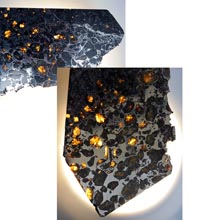 |
Meteorite Brahin Pallasite. Pallasites are the rarest and most beautiful of the three major types of meteorites, stony, stony-iron and iron-nickel originating at the core-mantle boundary of a very large asteroid that was destroyed by collision with another large asteroid more that 4 billion years ago. Pallasites are stony-iron meteorites composed of an iron nickel matrix filled with crystals of olivine which is known as Peridot in its gem form. This is a large 87 gram 5.25 x 2.35 inch gem quality polished slice of the Brahin Pallasite which was found in the Gomel Region of Belorussia in 1810. This extraordinary slice has many green translucent crystals of olivine some of which are of gem quality and thusly called Peridot. This rare and large pallasite comes with a stand for display.
Add $15 for domestic shipping.
Estimated Value $600 - 700.
View details and enlarged photo
| Realized
$561 |
Lot 998 |
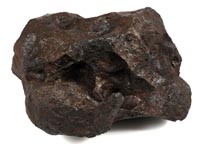 |
Meteorite Campo del Cielo 8 Pounds. This 6 x 5 x 3.25 inch 8 pound Campo del Cielo iron-nickel meteorites has an esthetic shape with its iron-nickel surface covered with desirable regmaglypts (thumbprints) that formed when the meteor passed through Earth's atmosphere and the troilite in the meteorite melted. In addition to its beautiful esthetic shape this large complete meteorite has several very deep regmaglypts. First recorded by the Spanish in 1576, the huge fall of Campo del Cielo (Valley of the Sky) iron-nickel meteorites occurred thousands of years before. The best quality Campos such as this splendid specimen were recovered high in the mountains where their surface was not rusted away by ground water. The Campo field has been mostly explored and the price of quality Campos is rising dramatically as new specimens are getting to be very difficult to locate and demand for meteorites has been steadily increasing. A much smaller five pound Campo del Cielo meteorite sold for over $3000 in a New York auction in September, 2007.
Allow $25 for domestic shipping: $25.
Estimated Value $900 - 1,200.
View details and enlarged photo
| Unsold |
Lot 999 |
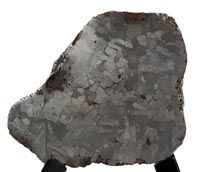 |
Meteorite Campo Del Cielo Etched Slice. The famous iron-nickel meteorite Campo del Cielo fell to the earth over 4,000 years ago in the mountainous region of Gran Chaco, Argentina, 500 miles north-northwest of Buenos Aires, in one of the largest and undoubtedly most dramatic falls in the last 10,000 years. Meteorites from this fall were scattered over hundreds of square miles of inaccessible terrain. This heavy 5.75 x 4.25 inch complete slice weighs 1,630 grams (over 3.5 pounds) and has been polished and etched to show its Widmanstatten pattern which results from two alloys of Nickel in the meteorite etching at different rates. There are no iron-nickel rocks on Earth that exibit a Widmanstatten pattern because the parent asteroid where these iron-nickel meteorites originate was destroyed by impact with another large asteroid and the new melted iron-nickel core had to cool at the very slow rate of a couple of degrees per million years to allow enough time for the nickel alloys Kamacite and Taenite to separate. This spectacular complete section has fusion crust all around and has been beautifully etched on both sides showing the coarse octahedrite pattern of this Type 1A iron-nickel meteorite with also an interesting circular troilite inclusion which is surrounded by black silicates and a thin layer of Screibersite. This museum quality meteorite comes mounted on a black metal stand for display.
Allow $20 for domestic shipping.
Estimated Value $675 - 850.
View details and enlarged photo
| Realized
$510 |
Lot 1000 |
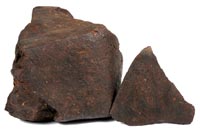 |
Meteorite Huge Stony End Piece With Cut Face. Most stony meteorites are small (less than 1 pound) because the larger stony meteorites usually break apart or explode before they contact the earth. This huge 5 x 4 x 4 inch 4.72 pound complete stony is one of the exceptions. It is designated as an unclassified NWA (North West Africa) stony meteorite and was found by nomadic Berbers in the sands of the Sahara desert of Morocco. It is an ordinary chondrite which means that it consists of round silicate grains that formed at the very beginning of the solar system 4.55 billion years ago from molten globs of accreted material that stuck together to form the asteroid from which this meteorite was blasted off when two asteroids collided. Of added importance is the presence of glissening flecks of iron throughout the meteorite and visible on the dark brown surface where the small iron flakes are reflective almost like micro diamonds. All stony meteorites contain iron and are designated as either low or high iron. This stony meteorite is medium to high iron with the iron and irregular shaped chondrites being quite distinct on the 2.75 x 2 inch cut and polished section as well as on the adjacent cut and polished face on one end of the meteorite. All of the rest of the meteorite is original just as found in the desert with a few cracks from the explosion and nearly complete thin dark brown fusion crust which occurred when the meteorite broke up and ablated at high temperature as it passed through the earth's atmosphere before contacting the ground. This meteorite looks as though it just landed on earth yesterday as most meteorites quickly become weathered from wind and rain but fortunately meteorites will retain their fusion crust for hundreds of years if they are buried in sand in a dessert.
Allow $20 for domestic shipping.
Estimated Value $950 - 1,250.
View details and enlarged photo
| Unsold |
Lot 1001 |
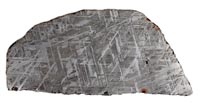 |
Meteorite Muonionalusta Slice. Muonionalusta is an iron-nickel meteorite that was found in Norrbotten, Sweden in 1906 and since then additional meteorites have been found in one of the largest strewnfields on earth at 30 x 10 kilometers. Muonionalusta is classified as a fine octahedrite and has one of the most beautiful Widmanstatten patterns when it is etched. Widmanstatten patterns form when the two alloys of nickel Kamacite and Taenite separate in the iron core of the large asteroid that was destroyed by collision with another large asteroid in the asteroid belt billions of years ago. This separation and pattern form only when the iron core cools at a rate of only a few degrees per million years and is not found on any iron-nickel stones on earth. This large 6.25 x 2.75 inch 162 gram section has been etched on both sides and displays one of the most beautiful Widmanstatten pattern found on any iron-nickel meteorite and is very similar to the pattern found on the Gibeon meteorite which is probably from the same parent asteroid body.
Allow $15 for domestic shipping.
Estimated Value $300 - 425.
View details and enlarged photo
| Unsold |
Lot 1002 |
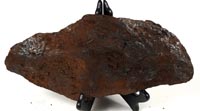 |
Meteorite Rare Ataxite. Ataxites are a rare type of iron-nickel meteorite that do not exhibit a Widmanstatten pattern when they are etched due to their high nickel content. Ataxites are known as ungrouped irons as they do not match the chemistry of any of the other iron-nickel groups and most certainly come from a different planetary body than the other irons. Dronino is an ataxite that was found by a Russian mushroom hunter in July of 2002 near the Russian village of Dronino. Over 600 meteorites were found totally about 3000Kg with the largest meteorite being 250Kg. All of the meteorites were heavily weathered and rusted from being buried underground from 1-6 feet. It is not known when this meteorite fell to earth but it was certainly more than one thousand years ago since the area was inhabited then and no mention of such a spectacular cosmic event is recorded. All specimens of Dronino are rather flat possessing few if any regmaglypts. This extremely large 13 x 6 x 1.5 inch 18 pound meteorite is one of the largest to be auctioned and possesses a typical gun metal surface with some traces of weathering. This museum sized meteorite comes with a wooden stand and is a rare chance to purchase an ataxite that is missing from many meteorite collections.
Allow $30 for domestic shipping.
Estimated Value $2,500 - 3,250.
View details and enlarged photo
| Realized
$1,440 |
Lot 1003 |
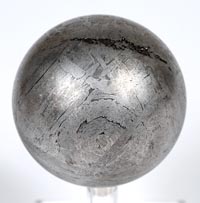 |
Meteorite Seymchan Pallasite. Two meteorites weighing 323 Kg were found in 1967 in Seymchan, a Magadan district in far eastern Russia. Originally, Seymchan was believed to be just an iron-nickel meteorite but just recently olivine crystals were found in parts of some of the Seymchan meteorites which makes it a far rarer Pallasite. Pallasites are literally gemstones from outer space containing olivine crystals mixed in with the iron-nickel matrix. This large 50mm in diameter 495 gram sphere has been polished and etched to display the lovely and distinctive Widmanstatten pattern found on a Seymchan as well as a couple of long troilite inclusions that are surrounded by Schreibersite. The brass colored Schretibersite is a rare iron-nickel phosphide mineral found only in iron-nickel meteorites. Even though Seymchan is a pallasite, no olivine crystals show on this cube. Widmanstatten patterns are unique to iron-nickel meteorites and are not found on any rocks on earth because the parent asteroid had to have been relatively small so that the pressure and temperature of the iron core would deformed and also large enough to allow a slow cooling rate in the core of only a few degrees per million years. Widmanstatten patterns are created by the separation of two allows of nickel, Kamacite low in nickel and Taenite with a high nickel content. The resulting crystalline structure of intersecting bands can be used to identify the meteorite with the bands being smaller with higher nickel content. Only the rare Glorietta Mountain Pallasite has a similar Widmanstatten pattern to Seymchan. This is a museum quality sphere that is mounted on a custom Lucite stand for display.
Allow $20 for domestic shipping.
Estimated Value $1,000 - 1,500.
View details and enlarged photo
| Realized
$738 |
Lot 1004 |
 |
Meteorite Sikhote-Alin With Flow Line. This huge 9 x 6.5 x 3 inch 12.5 pound Sikhote-Alin Iron-Nickel meteorite is one of the largest Sikhote-Alin meteorites ever auctioned. It is a very attractive and most interesting example of a shrapnel type Sikhote-Alin meteorite and shows many features of the huge explosion that took place on Feb. 10, 1947 high above the Sikhote-Alin mountains of Siberia. The enormous explosion tore the meteorite into thousands of smaller pieces and knocked people off their feet several miles away from the blast. The first explosion was high up in the atmosphere and the meteorites from this initial explosion exhibit regmaglypts(thumbprints) from melting for a longer time in the earth's atmosphere. The secondary explosions occurred much closer to the ground and these meteorites show the ripping force of the explosion resulting in sharp edges and there was not enough time to form the regmaglypts. This distinctive meteorite shows signs of the explosive shearing force with many sharp edges, distinctive attractive gun metal color, metal flowing over the edges and myriads of delicate flow lines on all sides of the meteorite. These delicate flow lines are only visible because of the freshness of this fall and flow in all kinds of directions reflecting the meteorite tumbling in the atmosphere before striking the ground. With a magnifying glass delicate feather-like and crisscrossing patterns can be easily seen. This Sikhote-Alin meteorite was saved by the meteorite hunter who found it due to these special surface conditions.
Allow $35 for domestic shipping.
Estimated Value $4,250 - 5,500.
View details and enlarged photo
| Unsold |
Lot 1005 |
 |
Meteorite Three Piece Type Set. There are three major types of meteorites, stony, stony-iron and iron-nickel. This lot contains a sizeable polished section from each type of meteorite. The stony meteorite which comes from the surface rocks of its parent asteroid is a 3.5 x2 inch 55.2 gram complete section of Dfofar 195 an ordinary chondrite from Oman. This meteorite has a dark brown surface with roundish chondrites and flecks of iron distributed throughout. The stony-iron specimen is a Pallasite, Pallosovka from Volgograd, Russia. Pallasites are literally gemstones from space with translucent olive crystal interspersed in an iron-nickel matrix. This large 2.3 x 2.3 inch 55 gram section has been polished to show the beautiful yellow-green olivine crystals with several being translucent. The third meteorite section is from an iron-nickel meteorite Muonionalusta which is from the artic circle of Norrbotten, Sweden. It is 3 x 2.5 inches weighing a heavy 100 grams and has been polished and etched revealing the distinctive fine octohedrite Widmanstatten pattern. This collection is housed in a 12 x 8 inch Riker Mount.
Add $20 for domestic shipping.
Estimated Value $500 - 700.
View details and enlarged photo
| Realized
$570 |
Lot 1006 |
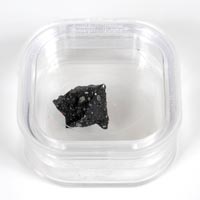 |
Own a Piece of a Comet. The Murchison meteorite is one of the most important and well studied meteorites ever discovered. Murchison meteorites landed in Australia in 1969 and were found to be the most primitive meteorites known, virtually unchanged since they formed at the same time as the solar system 4.57 billion years ago. Murchison meteorites contain 12 per cent water and many organic compounds which makes it very different from most of the meteorites which originate in the asteroid belt. NASA planetary scientists consider Murchison to be cometary in origin being a piece of the comet nucleus which broke off during a comets journey around the sun. What makes Murchison even more special is that it contains over 80 different amino acids. On earth there are only 19 Amino acids that make up all living creatures while Murchison contains these 19 plus 61 different amino acids. The presence of amino acids in a meteorite gives us a good idea as to the possible source of the building blocks of life. In the earth's early history there was a tremendous bombardment of meteorites and most if not all of the water found on earth today may have originated in comets. This sizable specimen of Murchison weighs .963 grams and is 12mm x 10mm x 5mm housed in a special membrane box for observation on all sides. The meteorite is a black color with lighter gray spherical chondrules. The United States, Europe and Japan are spending billions of dollars to bring back grains of meteorite dust from a comet while you can purchase a much larger piece of a comet for a few hundred dollars.
Allow $15 for domestic shipping.
Estimated Value $350 - 450.
View details and enlarged photo
| Realized
$708 |
Lot 1007 |
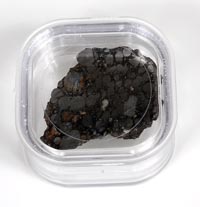 |
Rarest Stony Meteorite. Gujba, a Bencubbin-like meteorite, is the rarest of all types of stony meteorites, rarer than both Lunar and Martian meteorites. Gujba is a Carbonaceous Chondrite (Class CB) that contains more iron-nickel than stone. It is not a stony-iron meteorite like a Pallasite but rather just a stony meteorite with elliptical chondrules composed mostly of iron-nickel along with some troilite, silicate spheroids and metal rich olivine. More than 50% of the meteorite is composed of iron-nickel chondrules. Gujba fell April 3,1984 near Yobe, Nigeria and is called Bencubbin-like because its composition closely matches the first of this type of meteorite to be analyzed which was Bencubbin which fell in Western Australia in 1930. This 30 x 30 mm complete slice weighs 8.51 grams with natural fusion crust on all sides. It shows about 80% iron-nickel chondrules, some larger brecciated silicate chondrules including one large sea shell shaped chondrule that contains a mixture of reddish brown and gray minerals and a dark brown matrix. It is speculated that Gujba may be from one of the largest of the asteroids 2 Pallas (2nd asteroid to be discovered in 1802) because the spectra analysis of 2 Pallas closely matches the silicates of olivine and pyroxene found in the Bencubbin-like meteorites. Since the surface of 2 Pallas is low in iron, the iron-nickel in this meteorite would have come from an impact of 2 Pallas with an iron-nickel meteorite that resulted in a metal rich gas that condensed to form the unusual elliptical chondrules of iron-nickel and was mixed with the silicate globules from the surface of 2 Pallas. Using lead isotope dating of Gujba (4.563 billion years) indicates that this massive impact occurred within the first 2-3 million years after the formation of our solar system.
This rare meteorite slice is contained in a clear membrane box for viewing all surfaces including the fusion crust and placed in a 6 x 5 inch Riker Box. All meteorite collections should contain a specimen of the rare Bencubbin-like Carbonaceous meteorite.
Add $15 for domestic shipping.
Estimated Value $800 - 1,200.
View details and enlarged photo
| Unsold |